"I do not believe that women are better than men. We have not wrecked
railroads, nor corrupted
legislature, nor done many unholy things that men
have done; but then we must remember that we have
not had the chance."
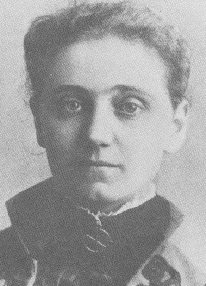 Jane Addams got the chance. The end of the eighteenth century may not have seen doors thrown wide open to women, but Jane Addams stuck her foot in the small crack of the door labled Social Work and squeezed through. Her success was a precedent for women who later crossed the threshold of other previously shut doors. "Helping the poor" was an acceptable occupation for a woman of leisure to partake in. Ms. Addams became the Chief Executive Officer of a company that influenced not only the immigrant poor but also university professors and government officials. Ms. Addams employed corporate strategies such as professional expertise, statistical analysis and research to produce a product - an assimilated, Americanized immigrant. The object of Hull-House as stated in its Charter was "to provide a center for a higher civic and social life; to institute and maintain educational and philanthropic enterprises, and to investigate and improve the conditions in the industrial districts of Chicago" (Addams). The assumption was that immigrants needed a "higher life."
Jane Addams got the chance. The end of the eighteenth century may not have seen doors thrown wide open to women, but Jane Addams stuck her foot in the small crack of the door labled Social Work and squeezed through. Her success was a precedent for women who later crossed the threshold of other previously shut doors. "Helping the poor" was an acceptable occupation for a woman of leisure to partake in. Ms. Addams became the Chief Executive Officer of a company that influenced not only the immigrant poor but also university professors and government officials. Ms. Addams employed corporate strategies such as professional expertise, statistical analysis and research to produce a product - an assimilated, Americanized immigrant. The object of Hull-House as stated in its Charter was "to provide a center for a higher civic and social life; to institute and maintain educational and philanthropic enterprises, and to investigate and improve the conditions in the industrial districts of Chicago" (Addams). The assumption was that immigrants needed a "higher life."
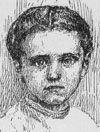 Laura Jane Addams, born in 1860 in Illinois, was a descendant of Quakers. Her mother died in childbirth and her successful businessman father, a friend of Abraham Lincoln's, exuded a strong influence on her intellect growing up. At the age of seven, Jane had her first view of poverty and announced that she would have a large house one day "built right in the midst of horrid little houses like these" (Addams). She later did. Jane had a keen mind and graduated from Rockford Seminary (Lundbland, 2). Her father's death in 1881 1eft Jane a substantial inheritance, allowing her to live comfortably the rest of her life. Even though family members encouraged her to marry, Jane stayed single. After completing two tours of Europe, Addams turned toward social work.
Laura Jane Addams, born in 1860 in Illinois, was a descendant of Quakers. Her mother died in childbirth and her successful businessman father, a friend of Abraham Lincoln's, exuded a strong influence on her intellect growing up. At the age of seven, Jane had her first view of poverty and announced that she would have a large house one day "built right in the midst of horrid little houses like these" (Addams). She later did. Jane had a keen mind and graduated from Rockford Seminary (Lundbland, 2). Her father's death in 1881 1eft Jane a substantial inheritance, allowing her to live comfortably the rest of her life. Even though family members encouraged her to marry, Jane stayed single. After completing two tours of Europe, Addams turned toward social work.
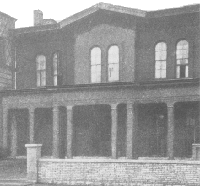 When Addams arrived in Chicago in 1889,
she joined the Woman's Club with the notion of recruiting well-educated,
privileged women like herself to aid in the establishment of her settlement. She and Ellen
Gates Starr, a friend from college, had spent time in Toynbee
Hall, the world's first settlement located in the "Dickensian warrens of England" (Miller,418).
At Toynbee, university men sought to morally uplift the economically deprived
with art exhibits and university extension classes. The idea of living
together in mutual dependency appealed to both Starr and Addams who earnestly
began to enlist society women. A settlement, according to Addams, "was a chance
for young women whose uselessness hangs about them heavily to engage in
morally purposeful work" (Miller, 419). There was no existing school of social work; Jane and her associates made it up as they went along.
When Starr and Addams found a run-down Halstead Street Mansion to rent,
Hull-House was born, and soon other women and men joined them in their "scheme," as Addams
called it.
When Addams arrived in Chicago in 1889,
she joined the Woman's Club with the notion of recruiting well-educated,
privileged women like herself to aid in the establishment of her settlement. She and Ellen
Gates Starr, a friend from college, had spent time in Toynbee
Hall, the world's first settlement located in the "Dickensian warrens of England" (Miller,418).
At Toynbee, university men sought to morally uplift the economically deprived
with art exhibits and university extension classes. The idea of living
together in mutual dependency appealed to both Starr and Addams who earnestly
began to enlist society women. A settlement, according to Addams, "was a chance
for young women whose uselessness hangs about them heavily to engage in
morally purposeful work" (Miller, 419). There was no existing school of social work; Jane and her associates made it up as they went along.
When Starr and Addams found a run-down Halstead Street Mansion to rent,
Hull-House was born, and soon other women and men joined them in their "scheme," as Addams
called it.
 Jane's achievement's did not end with Hull-House. Her CEO status led her to be on the "board of directors" for other organizations and she became the expert on numerous social issues. She somehow found the time to fight for woman's suffrage, lobby for child labor laws and found the Bureau of Organized Charities. In 1909, she attended a conference on childhood poverty in Washington D.C. at the request of President Theodore Roosevelt and helped bring "the entire subject before the country as whole and gave to social work a dignity and a place in the national life which it had never know before" (Addams). Addams worked closely with labor unions and was even appointed as an abitrator during the Pullman railroad strike of 1894.
Jane's achievement's did not end with Hull-House. Her CEO status led her to be on the "board of directors" for other organizations and she became the expert on numerous social issues. She somehow found the time to fight for woman's suffrage, lobby for child labor laws and found the Bureau of Organized Charities. In 1909, she attended a conference on childhood poverty in Washington D.C. at the request of President Theodore Roosevelt and helped bring "the entire subject before the country as whole and gave to social work a dignity and a place in the national life which it had never know before" (Addams). Addams worked closely with labor unions and was even appointed as an abitrator during the Pullman railroad strike of 1894. 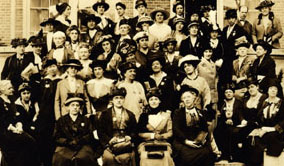 Jane was also a tireless proponent of peace and helped found the Women's International League for Peace and Freedom. Her pacifism eventually led her to be on Senate Judiciary Commitee's traitor list in 1919 but it also led her to win the Nobel Peace Prize in 1931 (Lundland,13). Jane was not alone in her endeavors. Hull-House residents followed her lead and fought for social justice right alongside her. Public support was not always on the side of Hull-House and one male critic stated that "Hull-House should divorce itsef from politics employer's associations, and trade unions"(Bryan and Davis, 119) and concentrate on the settlement work. The success of Hull-House gave Addams and other residents the power to make changes in previously male-dominated sectors of society.
Jane was also a tireless proponent of peace and helped found the Women's International League for Peace and Freedom. Her pacifism eventually led her to be on Senate Judiciary Commitee's traitor list in 1919 but it also led her to win the Nobel Peace Prize in 1931 (Lundland,13). Jane was not alone in her endeavors. Hull-House residents followed her lead and fought for social justice right alongside her. Public support was not always on the side of Hull-House and one male critic stated that "Hull-House should divorce itsef from politics employer's associations, and trade unions"(Bryan and Davis, 119) and concentrate on the settlement work. The success of Hull-House gave Addams and other residents the power to make changes in previously male-dominated sectors of society.
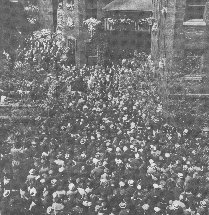 When Jane Addams died in 1935 at the age of 75, thousands of people attended the funeral in the Hull-House courtyard to say goodbye to to "Saint Jane."
A Chicago Herald and Examiner cartoon at time of her death
When Jane Addams died in 1935 at the age of 75, thousands of people attended the funeral in the Hull-House courtyard to say goodbye to to "Saint Jane."
A Chicago Herald and Examiner cartoon at time of her death  stated that her achievements were "carved in imperishable granite" and would withstand the waves of time. Hundreds of telgrams came from countries all over the world like Japan, India, Czechoslavakia, and England to offer condolences.
stated that her achievements were "carved in imperishable granite" and would withstand the waves of time. Hundreds of telgrams came from countries all over the world like Japan, India, Czechoslavakia, and England to offer condolences.
Jane Addams accomplished many firsts. She was among the first generation of American women to
attend college. She established the first settlement in Chicago which in turn established the first
public bath, playground, gymnasium, and kitchen. Hull-House played a part in
offering the first citizenship courses, first free art exhibits, first little theater, first college
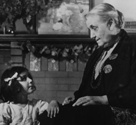 extension courses and the first boy scout troop. Jane and Hull-House completed the first investigations
that led to legislative action regarding factory laws and tenement codes. Jane Addams is the first
and only social worker to win the Noble Peace Prize for her dove philosophies. She is the first and only women to
have a monument in Chicago. She helped found the National Association for the Advancement of Colored People (NAACP). Jane wrote 10 books and over 200 articles, gave hundreds of speeches
and was awarded honorary degrees from thirteen universities, including being the first woman
to to receive an honorary degree from Yale. She wrote 10 books and more than 200 articles and delivered hundreds of speeches. She fought for
the right of women to vote and organized labor unions. Among social reformers
Jane Addams is a pioneer. As a CEO, she was one of the best.
extension courses and the first boy scout troop. Jane and Hull-House completed the first investigations
that led to legislative action regarding factory laws and tenement codes. Jane Addams is the first
and only social worker to win the Noble Peace Prize for her dove philosophies. She is the first and only women to
have a monument in Chicago. She helped found the National Association for the Advancement of Colored People (NAACP). Jane wrote 10 books and over 200 articles, gave hundreds of speeches
and was awarded honorary degrees from thirteen universities, including being the first woman
to to receive an honorary degree from Yale. She wrote 10 books and more than 200 articles and delivered hundreds of speeches. She fought for
the right of women to vote and organized labor unions. Among social reformers
Jane Addams is a pioneer. As a CEO, she was one of the best.

